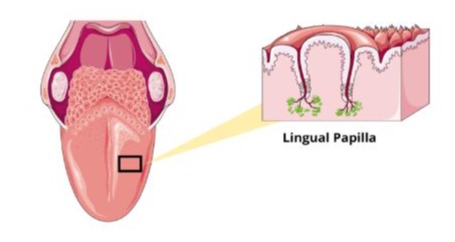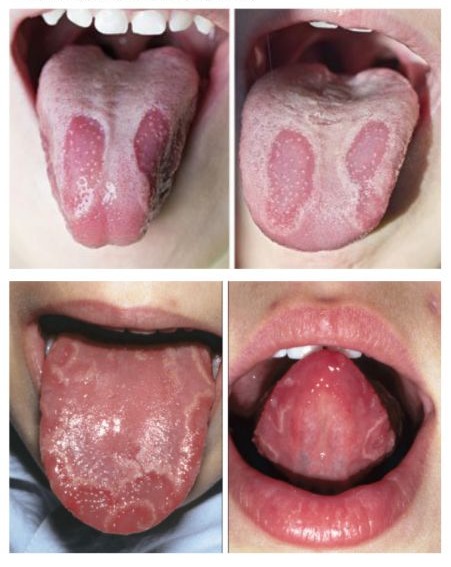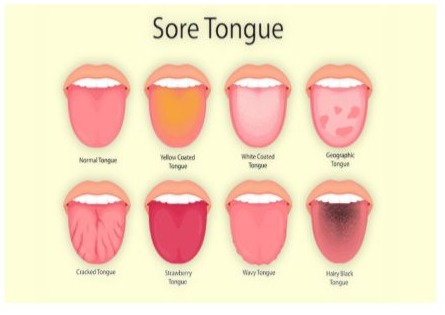The Role of Inflammatory and Environmental Factors in Geographic Tongue Disease
by Shahin Asadi*, Arezo Zare
Medical Genetics Director of the Division of Medical Genetics and Molecular Pathology Research, Division of Medical Genetics and Molecular Pathology Research, Center of Complex Disease, Mountain View, CA, USA
*Corresponding author: Shahin Asadi, Medical Genetics Director of the Division of Medical Genetics and Molecular Pathology Research. Division of Medical Genetics and Molecular Pathology Research, Center of Complex Disease, Mountain View, CA, USA
Received Date: 05 June 2025
Accepted Date: 10 June 2025
Published Date: 12 June 2025
Citation: Asadi S, Zare A (2025) The Role of Inflammatory and Environmental Factors in Geographic Tongue Disease. Adv Biochem Biotechnol 10: 10122 https://doi.org/10.29011/2574-7258.010122.
Abstract
Benign migratory glossitis, also known as geographic tongue, is a harmless condition that affects the mucous membrane of the tongue. It causes discolored, non-pigmented patches on the surface of the tongue, often appearing as island-like patches, giving the surface of the tongue a map-like appearance. Geographic tongue is an unusual condition, and you may be concerned about the appearance of your tongue. However, it is a benign and harmless condition. In fact, some people may not know they have it until their doctor accidentally notices it during a routine dental exam. Geographic tongue is a condition in which parts of the tongue appear whiter than the rest of the tongue. The scientific name for this condition is benign migratory glossitis, but it is called geographic tongue because the surface of the tongue often resembles an aerial map of geographical features. Fortunately, this disease is harmless, and people who are quickly familiar with the symptoms of oral cancer may think they have oral cancer. After observing any unusual phenomenon in the mouth, visit the dentist while maintaining composure. Rest assured that in most cases, it does not threaten you with a particular problem, but you should definitely visit the dentist to be sure. Geographic tongue is a benign condition characterized by inflammation of the tongue (glossitis) that appears in a map-like (geographic) pattern. The normal tongue is covered by a layer of small bumps called papillae. In affected individuals, certain areas of the tongue lack these bumps. These affected areas usually appear as flat, red or pink, atrophic patches. Geographic tongue tends to come and go, usually improving without treatment, but it often recurs, usually affecting a different area of the tongue. The exact cause of geographic tongue is unknown. The condition often runs in families, suggesting that genetics may play a role in causing the disorder.
Keywords: Cancer; Geographic Tongue; Glossitis, Inflammation; Oral Disorders
Geographic Tongue Overview
Geographic tongue is a benign condition characterized by inflammation of the tongue (glossitis) that appears in a map-like (geographic) pattern. The normal tongue is covered by a layer of small bumps called papillae. In affected individuals, certain areas of the tongue lack these bumps. These affected areas usually appear as flat, red or pink, atrophic patches. Geographic tongue tends to come and go, usually improving without treatment, but it often recurs, usually affecting a different area of the tongue. Most cases are asymptomatic (asymptomatic), and the condition usually goes away without treatment. Geographic tongue is not associated with any long-term health complications in healthy people. The exact cause of geographic tongue is unknow [1].
Clinical Signs and Symptoms of Geographic Tongue
In many cases, geographic tongue causes no symptoms (asymptomatic). Symptoms reported in association with geographic tongue include general discomfort of the tongue or mouth and a pain or burning sensation of the tongue, often made worse by spicy or acidic foods. The characteristic lesion in geographic tongue is reddish (erythematous), degenerated (atrophic) patches or an area on the tongue that is abnormally smooth due to the absence of the small ridges that normally cover the tongue. These patches may have slightly raised, yellow, or white margins. These patches cover the tongue in an irregular pattern, giving the tongue a map-like appearance. The patches may change in size, shape, and location from day to day [1] (Figure 1).

Figure 1: Schematic of the structure of geographic language [1].
Common features of geographic tongue include
- Fuzz-free patches or lesions on the surface of the tongue.
- Discoloration of the tongue with patches that are usually white.
- Raised areas on the tongue with a well-defined border.
- Sometimes, lesions appear on other mucosal areas of the body, such as the labia (outer lips of the vagina) [1].
People with geographic tongue may have periods during which symptoms disappear, but the lesions can return. In addition to coming and going randomly, the lesions may change in size, shape, location, or color (usually appearing white, yellow, pink, or red). Only one area of the tongue may be affected, or multiple areas may have patches and lesions. [1] The lesions may change slowly over a few days, but sometimes geographic tongue lesions can change over the course of a day or even within a few hours. [1] People often worry that the lesions associated with geographic tongue will make them more susceptible to other health problems, but there is no evidence that the condition increases the risk of more serious diseases such as oral cancer. [1] For most people, the condition is painless. However, some people who experience geographic tongue are sensitive to hot or spicy foods, acidic foods such as citrus fruits, alcohol, and tobacco [1],
Note: Geographic tongue often causes no other symptoms than discoloration and spots on the tongue. It is usually painless and does not cause long-term damage to the tongue. However, it may cause sensitivity to certain types of spices or acidic foods. [1] In some cases, pain may occur or the lymph nodes under the lower jaw (submandibular lymph nodes) may become enlarged. In rare cases, the pain or discomfort may be constant. The pain is usually caused by acidic foods that irritate the lesions. Avoiding acidic foods and drinks can help reduce discomfort. [1] When these lesions affect other areas of the mouth, other than the tongue, the condition may be called by another name, such as erythema migrans or geographic stomatitis. Such areas include the mucous membrane lining the inside of the cheek (buccal mucosa), the floor of the mouth, the roof of the mouth, and the gums (gingiva) [1].
Etiology of Geographic Tongue
The exact cause of geographic tongue is unknown. The condition often runs in families, suggesting that genetics may play a role in causing the disorder. Geographic tongue is often accompanied by a fissured tongue, a condition with a strong genetic link, further suggesting that heredity plays a role in the development of geographic tongu [1,2]. Fissured tongue is a benign condition characterized by multiple shallow or deep grooves or furrows on the dorsal (back) surface of the tongue. The surface grooves may vary in size and depth, radiate outward, and give the tongue a wrinkled appearance [1,2] (Figure 2).

Figure 2: Pictures of geographic tongue disease [1].
The exact cause of geographic tongue is unknown. However, there are many theories about the condition. Many people with the condition say that the lesions appear during times of stress. The condition also seems to run in families, meaning that there may be a genetic or environmental cause. One study that looked at the possible link to psoriasis identified a possible genetic link. Specifically, people with geographic tongue may have a variant of the gene that codes for a protein called interleukin-1 beta (IL-1B) [1,2].
In some cases, certain habits, such as teeth grinding, have been linked to an increased risk of developing geographic tongue. Additionally, people with grooves along the surface of their tongue, a condition known as fissured tongue, may be more likely to develop geographic tongue [1,2]. In addition to fissured tongue, geographic tongue is associated with many other conditions, most notably psoriasis. Psoriasis is a chronic, inflammatory skin disease characterized by patches of dry, red (erythematous), thick skin covered with silvery-gray scales. These patches may be known as papules or plaques and often involve the scalp, elbows, knees, hands, feet, or back. Additional conditions that may occur in association with geographic tongue include allergies, emotional stress, juvenile diabetes, Reiter's syndrome, and hormonal disorders. However, no definitive link has been made between geographic tongue and any of these conditions [1,2].
Other Potential Causes of Geographic Tongue Include
- Diet-related causes (food sensitivities and nutrient deficiencies)
- Allergies (metals and environmental substances)
- Hormonal causes (oral contraceptive use)
- Skin diseases (psoriasis and eczema)
- Autoimmune disorders and other inflammatory conditions
- Chronic diseases (diabetes)
- Hereditary disorders (chronic granulomatous disease, a genetic disorder that causes abnormal white blood cells)
Geographic tongue affects both men and women of all ages and races. It appears to occur most often in children. Although it is believed to affect a very small percentage of the population, many people may not realize they have the condition [1,2]. Genetic factors: Some studies suggest that the condition may run in families, suggesting a possible role for genetic factors. [1,2] Immune system: Immune system disorders may play a role in the development of this condition. [1,2] Environmental triggers: Some environmental triggers, such as certain foods, stress, hormonal changes, and some medications, may worsen symptoms or cause the condition to recur. [1,2] Comorbidities: People with skin conditions such as psoriasis or eczema are more likely to develop geographic tongue. [1,2] Nutritional deficiencies: Deficiencies in certain vitamins and minerals, such as iron and folate, may also be linked to this condition [1,2].
Exacerbating Factors
Stress: Stress can worsen the symptoms of geographic tongue [1,2].
Hormonal Changes: Hormonal changes during menstruation, pregnancy, and menopause may worsen symptoms [1,2].
Eating Certain Foods: Spicy, acidic, salty, or allergenic foods may irritate tongue spots [1,2].
Taking Certain Medications: Some medications, such as nonsteroidal anti-inflammatory drugs (NSAIDs), may worsen symptoms [1,2].

Figure 3: Schematic of different types of tongue diseases [1].
Frequency of Geographic Tongue
Some reports in the medical literature suggest that geographic tongue affects women slightly more often than men. It appears to occur more frequently in young adults. The prevalence of geographic tongue is unknown, but it is estimated to occur in approximately 1-3% of the general population [1,2].
Disorders Associated with Geographic Tongue
The following disorders can have similar symptoms to those of geographic tongue. Comparisons may be helpful in making a differential diagnosis: A variety of conditions can affect the tongue, including infection with a harmless type of yeast (oral candidiasis), burning mouth syndrome, an inflammatory condition characterized in part by grayish-white patches in the mouth (lichen planus), and oral cancers. Tongue cancer is a general term for two types of cancer, one that affects the part of the tongue that can protrude from the mouth and the other that affects the base of the tongue at the back of the mouth. The first type is classified as oral (or mouth) cancer and the second type is oropharyngeal cancer. Oropharyngeal cancer is cancer that occurs in the throat near the back of the mouth. Geographic tongue is not related to oral cancers and is not a premalignant condition [1,2].
Diagnosis of Geographic Tongue
The diagnosis of geographic tongue is based on a complete clinical evaluation, a detailed patient history, and the characteristic appearance of the tongue lesions associated with the condition. In most cases, surgical removal and microscopic study (biopsy) of the affected tissue is not necessary due to the distinctive appearance of the tongue [1,3]. Geographic tongue is often discovered by chance and may be discovered by a doctor or dentist during a routine checkup. However, some people specifically seek treatment for their tongue because they are concerned that the symptoms they are experiencing could be a sign of a serious health problem, such as an infection or cancer. Before diagnosing geographic tongue, a doctor will visually examine your mouth and ask questions such as “when did the lesions appear” and “whether the lesions cause pain.” Doctors usually do not need to order any specific tests to diagnose geographic tongue. If there is uncertainty about the diagnosis, or if doctors want to rule out other conditions, they may take a tissue sample from the tongue for a biopsy [1,3].
Overview of Geographic Tongue A Benign Inflammatory Condition.
Other conditions that can resemble geographic tongue include:
- Chemical burns
- Psoriasis
- Fungal infections such as candidiasis
- Lichen planus
- Contact stomatitis (sensitivity or allergic reactions to substances such as toothpaste)
- Oral cancers (rare)
Note: There are several theories about the cause of geographic tongue. Genetic factors, food sensitivities or allergies, birth control pills, or underlying medical conditions may all contribute to the condition. There is no specific test for geographic tongue. A doctor will make a diagnosis based on symptoms while ruling out other possible causes.
Treatment Options for Geographic Tongue
This benign condition does not require drug treatment. Some doctors advise patients to avoid irritants and substances that may irritate the tongue. A bland or liquid diet, preferably cool, may be best. Good oral hygiene is important, but care must be taken to maintain a healthy bacterial balance in the mouth. If pain or discomfort is persistent, some doctors may recommend anti-inflammatory medications or numbing medications applied directly to the affected areas (topical analgesics). [1,4] Geographic tongue does not require any treatment because it is a benign condition, resolves on its own, and is usually painless. If a person with this condition notices allergies to certain foods, drinks, or substances (such as tobacco or toothpaste), they should be aware of what triggers the lesions and avoid them if the condition is present or reoccurs [1,4]. If you have persistent pain or sensitivity, your doctor may prescribe topical treatments such as corticosteroids to treat geographic tongue. If the pain is severe, local anesthetics or agents that numb the tongue may be recommended. Mouthwashes can also be used to relieve any discomfort associated with the condition. [1,4] In some cases, anti-allergy medications (antihistamines) may be helpful. However, if you experience geographic tongue as a result of a chronic condition (such as psoriasis), you will need to treat the underlying condition in order for the lesions to improve. [1,4]. Geographic tongue usually has mild or no symptoms. Your tongue may have changes in appearance that come and go, but these changes do not cause permanent damage to the tongue. There are no long-term consequences associated with geographic tongue. [1,4]. Although there are theories about how geographic tongue develops, none have been proven. Your doctor can diagnose the condition based on your symptoms. However, they may need to do further tests to make sure that the tongue lesions and other symptoms are not related to an underlying condition that requires treatment [1,4].
Discussion
Geographic tongue is a benign condition characterized by inflammation of the tongue (glossitis) that appears in a map-like (geographic) pattern. The normal tongue is covered by a layer of small bumps called papillae. In affected individuals, certain areas of the tongue lack these bumps. Geographic tongue is a benign condition and usually does not require specific treatment, as it improves on its own. However, some treatments can be helpful to relieve symptoms and increase comfort [1-4].
Geographic tongue home remedies and care
Avoid triggers: Avoid spicy, acidic, salty, or allergenic foods.
Use mild mouthwashes: Mild, alcohol-free mouthwashes can help reduce inflammation and relieve pain.
Eat a healthy diet: Eating nutritious foods rich in vitamins and minerals can help improve oral health.
Stress Reduction: Relaxation techniques such as meditation and yoga can help reduce stress and improve symptoms.
Drug Treatments
In some cases, your doctor may prescribe the following medications to reduce inflammation and relieve pai:
Corticosteroids: These medications can be taken as a mouthwash or pill to reduce inflammation.
Antihistamines: These medications are helpful for reducing itching and inflammation.
Other Treatments
Laser therapy: In some cases, laser therapy is used to relieve pain and improve the appearance of the tongue.
Surgery: Surgery is rarely needed to treat geographic tongue and is usually done to treat other problems that accompany the condition [1-4].
Important
See a doctor: If your symptoms are severe or bothersome, be sure to see a doctor or dentist to determine the exact cause and prescribe the right treatment for you.
Patience: Geographic tongue may take time to heal, and spots on the tongue may appear and disappear for a while [1-4].
Remember
- Geographic tongue is a harmless condition and is usually not dangerous.
- Home remedies and care are enough to reduce symptoms in many cases.
- If your symptoms do not improve or worsen, be sure to see a doctor [1-4].
References
- Asadi S, Human Idiopathic Diseases Books (4 Vol) Amidi Publications 2025.
- Gonzalez-Alvarez L, Garcia-Martin JM, Garcia-Pola MJ (2019) Association between geographic tongue and psoriasis: A systematic review and meta-analysis. J Oral Pathol Med 48: 365-372.
- Dafar A, Cevik-Aras H, Robledo-Sierra J, Mattsson U, Jontell M (2016) Factors associated with geographic tongue and fissured tongue. Acta Odontol Scand 74: 210-216.
- Kelsch R (2018) Geographic Tongue.Medscape 2018.
© by the Authors & Gavin Publishers. This is an Open Access Journal Article Published Under Attribution-Share Alike CC BY-SA: Creative Commons Attribution-Share Alike 4.0 International License. Read More About Open Access Policy.